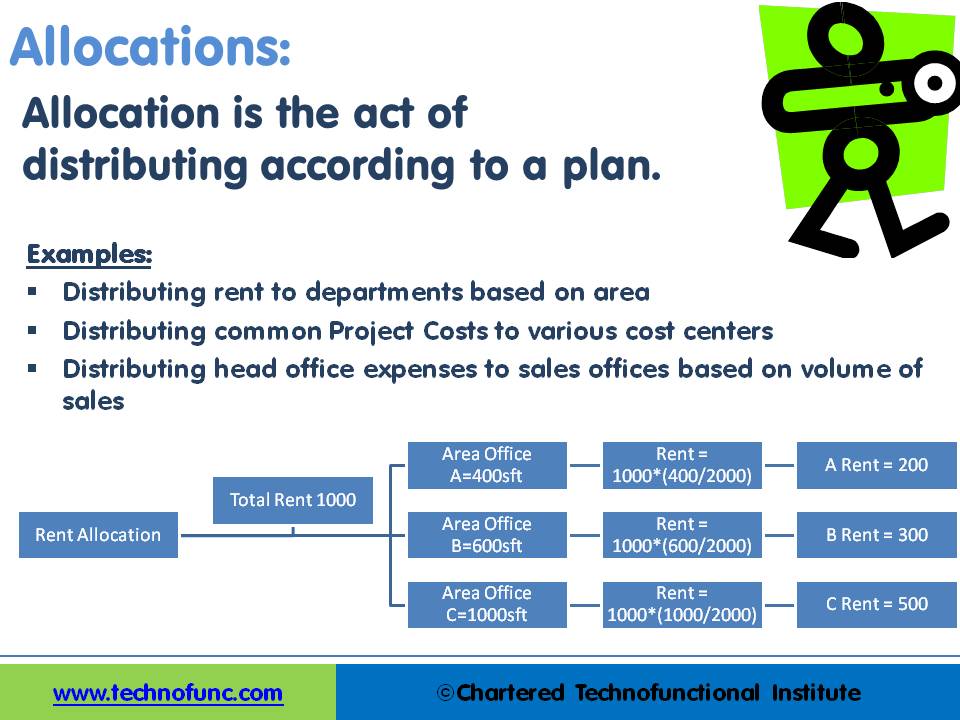- Home
- Business Processes
- Industry Knowledge
- Aerospace Industry
- Automotive Industry
- Banking Domain
- BFSI Industry
- Consumer/ FMCG Industry
- Chemicals Industry
- Engineering & Construction
- Energy Industry
- Education Domain
- Finance Domain
- Hospitality Domain
- Healthcare Industry
- Insurance Domain
- Retail Industry
- Travel and Tourism Domain
- Telecom Industry
- Leadership Skills
- eLearning
- Home
- Functional
- General Ledger (Record to Report)
- GL - Account Allocations
GL - Account Allocations
An allocation is a process of shifting overhead costs to cost objects, using a rational basis of allotment. Understand what is the meaning of allocation in the accounting context and how defining mass allocations simplifies the process of allocating overheads to various accounting segments. Explore types of allocations and see some practical examples of mass allocations in real business situations.
What is Account Allocation?
Allocation is the act of distributing according to a plan. As per the dictionary allocate means to set apart for a special purpose; designate; distribute according to a plan. From an accounting context, it means a system of dividing overhead expenses between the various departments of a business. Figuratively, earmarked is often used in regard to monetary allocations although it is heard in other contexts as well.
The allocation also refers to a piece of the pie, a share in the profits, a portion of whatever is being divided up and parceled out usually money, but in an accounting context is applicable to account balances. This expression probably has its origin in the graphic representation of budget allotments in circular, pie-shaped form, with various sized wedges or pieces indicating the relative size of allocations to different agencies, departments, etc.
Concept of Mass Allocations:
Mass allocations is a functionality offered by many automated systems and ERPs to distribute the account balances from one account to several others based on a formula or mathematic logic. Users can define a Mass Allocation formula to create journals that allocate revenues and expenses across a group of cost centers, departments, divisions, locations, and so on using any accounting dimension available. Users can include parent values in allocation formulas that can enable allocating to the child values referenced by the parent without having to enumerate each child separately.

Different Type of Allocations:
The commonly used allocations can be grouped as follows:
- Net Allocations: allocated amounts that reflect changes to the cost pool.
- Step–Down Allocations: distributing amounts from one allocation pool to a subsidiary allocation pool.
- Rate-Based Allocations: using current, historical, or estimated rates to allocate costs.
- Usage-Based Allocations: using statistics such as headcount, units sold, square footage, number of deliveries, or computer time consumed to calculate allocation amounts.
- Standard Costing Allocations: using statistics such as sales units, production units, number of deliveries or customers served to perform standard costing.
Examples of Allocation:
Allocations can be used in various practical business situations. For example, consolidated rent paid can be allocated to another division based on the area of usage, or, a pool of marketing costs can be allocated to several departments based on the ratio of department revenues to total revenues. Some of the commonly used examples are:
- Distributing rent to departments based on area
- Distributing common project costs to various cost centers
- Distributing head office expenses to sales offices based on the volume of sales
- Distributing marketing costs to product lines based on revenue
- Distributing common employee expenses to employee cost for assessments
In the example shown in the figure, we have a company which has taken a 1000 square feet office space on rent. The expenses for rent are borne by the head-office and payment to the landlord is also made by the head office. To know the true profitability of each of the departments (Department A, B & C) the rent needs to be allocated to each one of them.
Each department occupies different areas and the company has taken the measurement of the areas occupied by each of the departments. In the example shown here, the rent is being allocated to different departments based on their usage factor. This is an example of the concept of allocation and automated accounting systems help handle complex allocations programmatically.
Difference between Allocations & Recurring Journals:
Recurring Journals are for transactions that repeat every accounting period and allocation Journals are for single journal entry using an accounting or mathematical formula to allocate revenues and expenses across a group of accounting dimensions like cost centers, departments, divisions, locations, or product lines depending upon usage factors.
Related Links
You May Also Like
-
An organizational design is the process by which a company defines and manages elements of structure so that an organization can control the activities necessary to achieve its goals. Good organizational structure and design helps improve communication, increase productivity, and inspire innovation. Organizational structure is the formal system of task and activity relationships to clearly define how people coordinate their actions and use resources to achieve organizational goals.
-
A joint venture (JV) is a business agreement in which the parties agree to develop, for a finite time, a new entity and new assets by contributing equity. They exercise control over the enterprise and consequently share revenues, expenses and assets. A joint venture takes place when two or more parties come together to take on one project.
-
Network Organizational Structures
The newest, and most divergent, team structure is commonly known as a Network Structure (also called "lean" structure) has central, core functions that operate the strategic business. It outsources or subcontracts non-core functions. When an organization needs to control other organizations or agencies whose participation is essential to the success, a network structure is organized.
-
Matrix Organizational Structures
In recent times the two types of organization structures which have evolved are the matrix organization and the network organization. Rigid departmentalization is being complemented by the use of teams that cross over traditional departmental lines.
-
In this article we will help you understand the double-entry accounting system and state the accounting equation and define each element of the equation. Then we will describe and illustrate how business transactions can be recorded in terms of the resulting change in the elements of the accounting equation.
-
Concept of Representative Office
A representative office is the easiest option for a company planning to start its operations in a foreign country. The company need not incorporate a separate legal entity nor trigger corporate income tax, as long as the activities are limited in nature.
-
An account inquiry is a review of any type of financial account, whether it be a depository account or a credit account. In this tutorial, you learn what we mean by drill through functionality in the context of the general ledger system. We will explain the concept of drill-down and how it enables users to perform account and transaction inquiry at a granular level and the benefits of using this functionality.
-
Introduction to Legal Entities Concept
Modern business organizations operate globally and leverage a large number of registered legal entities, and operate through complex matrix relationships. To stay competitive in the current global business environment, they must often develop highly diverse and complex organizational structures that cross international borders. Learn more about Legal Entities and their importance for businesses.
-
In this article, we will explain the general Ledger journal processing flow from entering journals to running the final financial reports. Understand the generic general ledger process flow as it happens in automated ERP systems. The accounting cycle explains the flow of converting raw accounting data to financial information whereas general ledger process flow explains how journals flow in the system.
-
In most of the automated financial systems, you can define more than 12 accounting periods in a financial year. This article will explain the concept of the adjustment period and the benefits of having adjustment periods. Adjustment periods have their inherent challenges for the users of financial statements and there is a workaround for those who don’t want to use adjustment periods.
Explore Our Free Training Articles or
Sign Up to Start With Our eLearning Courses

About Us
Learning
© 2023 TechnoFunc, All Rights Reserved










